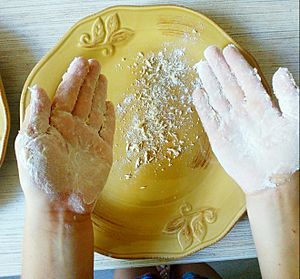Zatiruha facts for kids

Making noodles for zatiruha
|
|
| Type | Soup |
|---|---|
| Place of origin | Russia |
| Associated national cuisine | Russian |
| Serving temperature | Hot or cold |
| Main ingredients | Noodle, broth, milk, water |
Zatiruha (sometimes called zatiukha or zatirukha) is a yummy Russian soup. It's special because it uses handmade noodles. This soup is a type of paste soup or flour soup.
The name Zatiruha comes from a Russian word that means "to rub." This is because the noodles are made by rubbing floury hands together. This creates small, pellet-like pieces of dough or noodles. Long ago, it was known as a simple dish for everyday people.
You might find similar dishes in other countries too! In Belarus, it's called zatsirka. In Ukraine, it's known as zatirka. There's also a dish called umach ashi in other places. In Poland, a similar dish is called "Zacierki" and is often served as a milk soup.
The Story Behind Zatiruha
There's a cool legend about how Zatiruha might have started. The story says that a worker in a rich house had just finished making bread dough. Instead of washing her hands, she went home. There, she rubbed her palms together over a plate. Small pieces of dough fell off her hands. She then boiled these dough pellets to feed her children. And that's how this simple, hearty soup might have been born!
How to Make Zatiruha
Making Zatiruha is quite unique! First, you dip your hands into a beaten egg, some milk, or water. Then, you dip your wet hands into flour. After that, you rub your palms together over a plate. As you rub, small dough pellets will form and fall onto the plate.
These little dough pieces are then boiled in a tasty broth or water. You can add other ingredients to make your soup even better! Some popular additions include potatoes, cooked onions, and carrots. Fresh green onions, parsley, and dill also add great flavor. Bay leaves and other seasonings are often used too.
Sometimes, people add meat or mushrooms to their Zatiruha for a heartier meal. You can even make a milk soup or a type of porridge using this same special method of rubbing dough. It's a simple and fun way to make a meal!

